Toshiba Satellite A660D-ST2G01: AMD's Quad-Core Phenom II P920 Joins the Mobile Party
by Jarred Walton on August 31, 2010 12:45 AM ESTToshiba A660D-ST2G01 General Performance
As one of the first up-to-date AMD notebooks to hit our labs in a long time, the Toshiba A660D certainly piqued our interest. Where will the quad-core P920 fall in regards to the competition? How much will battery life improve? How does gaming fare? You've got questions, and we've got the answers. Here's a recap of the pertinent details of our test system.
| Toshiba A660D-ST2G01 Test System | |
| Processor |
AMD Phenom II P920 (4x1.6GHz, 45nm, 4x512KB L2, 25W) |
| Chipset | AMD RS880M Northbridge, AMD SB850 Southbridge |
| Memory | 2x2GB DDR3-1066 (Max 2x4GB) |
| Graphics |
ATI Mobility Radeon HD 4250 (40 Stream Processors, 500MHz Core, Integrated) ATI Mobility Radeon HD 5650 (400 Stream Processors, 450MHz Core, 1600MHz GDDR3) |
| Display |
16" LED Glossy 16:9 768p (1366x768) Samsung 160AT06-U01 |
| Hard Drive(s) | Toshiba 500GB 7200 RPM Hard Disk |
| Optical Drive | DVD+/-RW Combo Drive with LabelFlash |
| Battery | 6-Cell, 10.8V, 48Wh battery |
| Operating System | Windows 7 Home Premium 64-bit |
| Pricing |
Starting at $949 Online A665D-S6059: $800 Online |
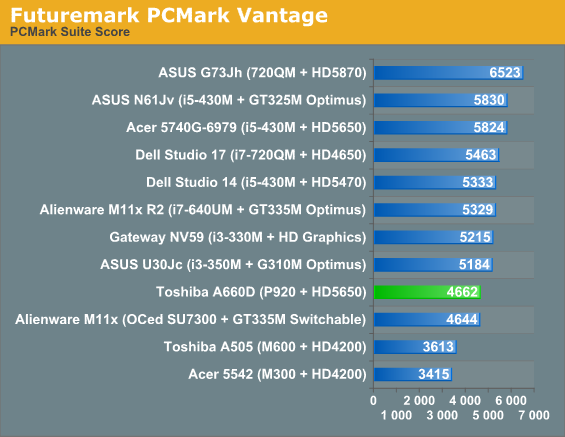
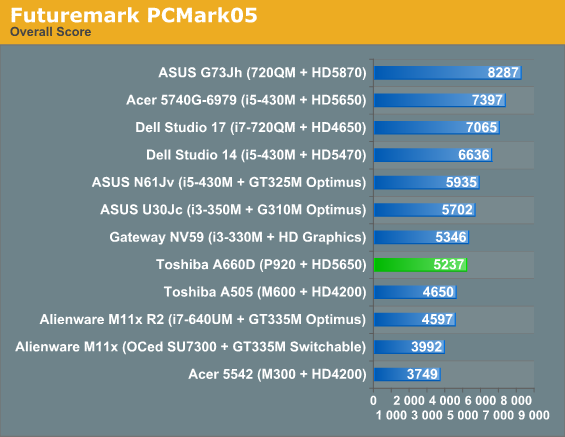
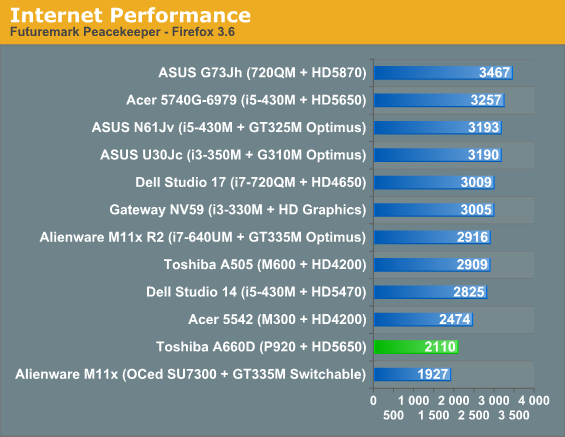
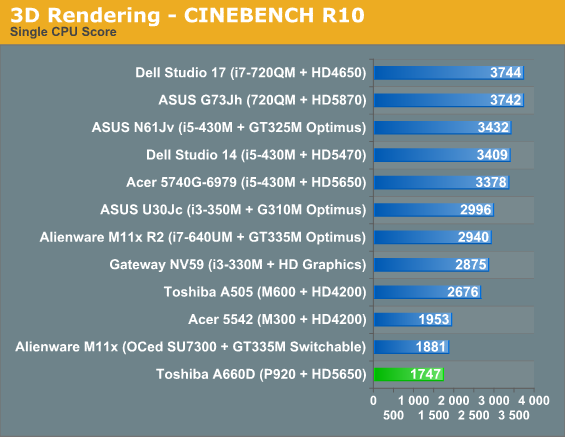
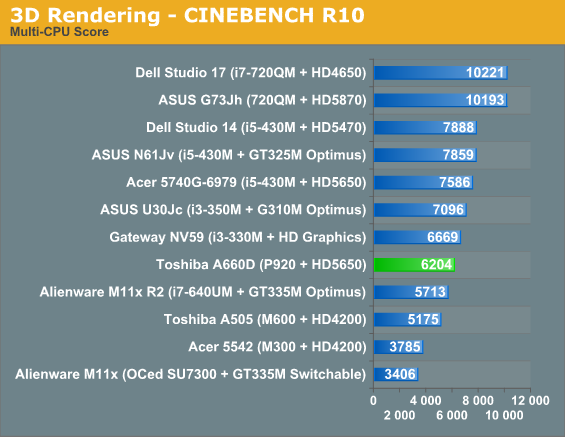

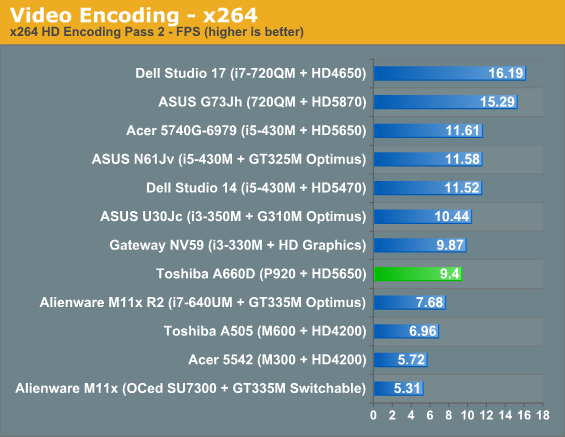
Starting off with PCMark Vantage and PCMark05, we get our first glimpse of the potential of the P920. Despite the lower clock speed, the P920 outpaces the Turion II M600 by 20% and the Athlon II M300 by 27% in Vantage. The gap is smaller in PCMark05, but that's obviously an old (outdated even) benchmark so we won't worry about it too much. That's the good news; the bad news is that Intel's slowest Core i3 processors are still faster in general application performance. The i3-330M with Intel HD Graphics is 20% faster, and the i5-430M with HD 5650 is 34% faster. The slow clock speed of the P920 just doesn't keep up in these types of workloads.
Peacekeeper shows the worst-case scenario where Intel's Turbo Boost is in full effect and the higher clocks of dual-core parts take front stage. On the AMD side, the M300 is 17% faster than the P920 and the M600 is 38% faster. Switch to Intel and the slowest i3-330M comes in 42% faster (ouch!), while the i5-430M is 54% faster. Heavily threaded tests don't do the P920 any favors either, as the i3-330M with Hyper-Threading still leads by a small amount in Cinebench SMP and x264 2nd pass. The only win for the P920 comes in the first pass of x264 encoding, where it's about 5% faster than the i3-330M.
What about the AMD quad-core versus Intel quad-core comparison? The ASUS G73Jh does come with a faster 5870 GPU, but even when we take that out of the picture the i7-720QM is clearly much faster than the P920. The gap is 50% in PCMark Vantage, and it goes up from there. The lead is 64% in Peacekeeper and 114% in the single-threaded Cinebench result, where Turbo Boost is in full effect. The lead in multi-core Cinebench is 64%, 2nd pass x264 is 63%, and the closest result is in the 1st pass x264 where the lead drops to just 19% (as memory and storage performance become bigger factors).
The P920 is certainly fast enough for most users, but the fact that a quad-core processor can't establish a lead over dual-core Intel parts even in multi-threaded tests is telling. Low power draws are good for battery life, but higher clock speeds are necessary to close the performance gap. We'd really like to see AMD put their Turbo Core technology from the desktop Phenom II X6 processors into their mobile parts, as the low 1.6GHz clock is definitely hurting performance in many tasks. In fact, there are a few instances where the overclocked SU7300 CULV processor (in the Alienware M11x) beats the P920. AMD does have some faster quad-core parts available, of course. N930 runs at 2.0GHz, which means it should be around 25% faster in CPU limited tasks, and the X920 BE runs at 2.30GHz, but those comes with 35W and 45 TDP, respectively. At lower loads those processors should use roughly the same power as the P920, but load power draw will be substantially higher.
The bottom line is that AMD's CPU cores could still use help, as clock for clock they're similar to the old Core 2 chips. Core 2 was available at speeds up to 3.07GHz dual-core and 2.53GHz quad-core, and even the fastest of those parts are surpassed by the midrange Core i3/i5/i7 parts. AMD is able to compete with Intel's old generation mobile hardware now, but that still means they're around 18 months behind. The result is that they need to sell at lower prices to stay relevant, and that's what they're doing.
Toshiba A660D-ST2G01 3DMark Performance
For those that like to compare 3DMarks, here are the results from the A660D (using the HD 5650 in all cases). Consider this a preview of the gaming performance on the next page.
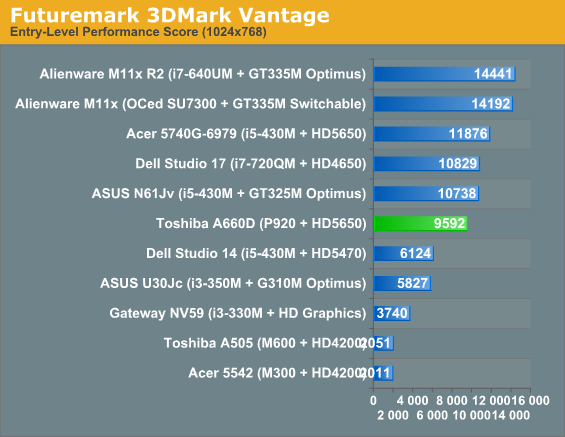
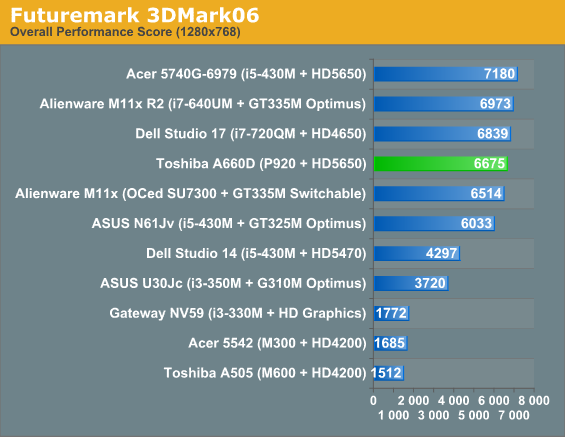
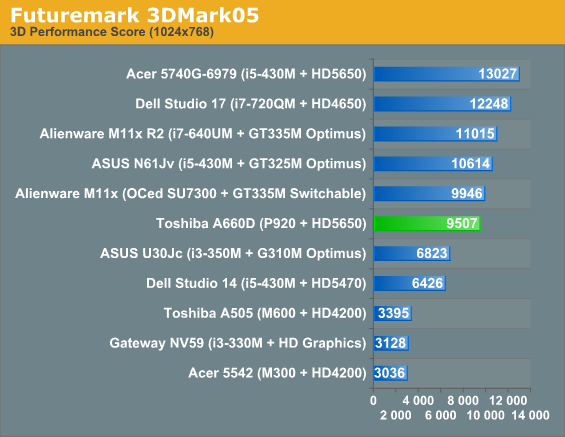

The only other HD 5650 system we've tested to date is the Acer 5740G (which is, sadly, discontinued—though you can get the 7740G if you don't mind the 17" chassis). As mentioned already, that 5650 was clocked at 550MHz compared to 450MHz in the A660D, plus it used an i5-430M CPU. The result is a performance lead of anywhere from 6% (3DMark06) to 36% (3DMark05) over the A660D, but what we don't know for sure is if the limiting factor is the CPU or the lower GPU clock. Most likely it's some of each, so let's look at actual gaming performance and see where the chips fall.










33 Comments
View All Comments
JarredWalton - Tuesday, August 31, 2010 - link
My Google-Fu was obviously weak. This is the only P520 + 5650 laptop around right now it seems, and we are working with AMD to get one. Acer likely will clock the 5650 at the full 550MHz as well, which would make it a lot more interesting.silentim - Tuesday, August 31, 2010 - link
Hi, nice review. Glad to see AMD back to the game. Intel need competition these days.I m sorry for being off-topic here, but I can't find any anandtech official email. I'd like to ask for review for system76, one of few OEM other than Apple to ship consumer laptop other than windows, ubuntu in this case. I want to have references where I can buy laptop without m$ tax other than overpriced Apple.
JarredWalton - Tuesday, August 31, 2010 - link
jarred.walton@anandtech.comanand@anandtech.com
dustin@anandtech.com
vivek@anandtech.com
ryan.smith@anandtech.com
One of those should work. ;-)
Cal123 - Tuesday, August 31, 2010 - link
Nice review btw, I thought it was objectively done. The only important thing I could think of to possibly add would be temp readings under load for cpu and gpu, to make sure the cooling system was up to snuff.andrewaggb - Tuesday, August 31, 2010 - link
I seriously considered getting one of these laptops about 2 weeks ago, until I realized it didn't have amd's version of turbo boost/core. One quick look at some starcraft cpu benchmarks made me realize I would get half the frame rate of the i7-720qm. I also wasn't sure if toshiba let you use amd's laptop drivers, which you say they don't. I got a gateway one instead for $200 more, but it has the intel quad core and you can use amd's drivers. No regrets. 50% slower frame rates just wasn't worth it.Roland00 - Wednesday, September 1, 2010 - link
AMD would be competive to Intel if it had turbo and powergating.For example the best 35w AMD processors that AMD currently has are these three models
AMD Phenom II x4 n930 at 4x2.0 ghz
AMD Phenom II x3 n830 at 3x2.1 ghz
AMD Phenom II x2 n620 at 2x2.8 ghz
Now compare that to intel i7 720qm which works as follows with turbo (note this is a 45w processor)
1.6 ghz Quad Core no turbo
1.73 ghz Quad Core with turbo
2.40 ghz Dual Core with turbo
2.80 ghz Single Core with turbo
If AMD had turbo and power gating it would not be unreasonable that the n930 could act as a 2.0 ghz quad core and a 2.8 ghz dual core. Thus if we are comparing straight ghz amd would possess 25% more ghz as a quad core with no turbo, 16% more ghz as a quad core, and 16% more ghz as a dual core. Now comparing ghz from different architectures is foolish for they are not the same thing, that said intel i7 mobile has a higher ipc than the phenom II mobile (which is a variant of the Athlon IIx4 of Desktops). That said the higher ipc of intel vs the higher ghz of AMD would put them real close in final speed (intel may win the benchmarks, but ask a person to "feel the difference in speed" and they would be hard pressed to differentiate.)
Sadly AMD has no turbo or powergating thus it won't be comparable. Rumors say llano will have these features, thus that is good news for AMD, but then AMD will be competing against mobile Sandybridge which will be 10-30% faster compared to Nehalem.
LaptopDoctor - Wednesday, September 1, 2010 - link
I own and operate a laptop repair business and after reading months of comments in various articles where folks are trying to justify AMD's recent poor performance, I thought I would throw in my two cents. Over the past 2-3 years I observed (and fixed) a 12 to 1 ratio of AMD based failures to Intel...mostly because of over-heating and chipset failures (HP's DV series is a great example). Seems like the vendors are trying to make AMD products compete at the mid to higher levels in thermal packaging which can't hold up much past the limited 12 month warranty. Guess this is why you can't find a ThinkPad (T-Series) with an AMD solution inside it. Unfortunately the consumers purchasing the Toshibas and HPs in this price range are really the ultimate loosers. It would be interesting for this forum to take a look at longivity in addition to speed. A fast laptop that lasts 12.5 months is a bad investment regardless of how many frames per second it can do!!!The Crying Man - Wednesday, September 1, 2010 - link
Can you specify the most common AMD CPUs? I have an HP L2005CM with a Turion 64 that's still running after 4 years with the first 2 years seeing heavy use. Curious if my CPU is part of that or if it's more with the Turion Ultras that came out after.LaptopDoctor - Thursday, September 2, 2010 - link
In most cases it is a HP, Compaq, or Toshiba with Turion 64 based system with Nvidia chipset...best examples are HP DV2000,DV6000,DV9000,Compaq F500/700 series etc. But in general it is in the retail packaging versions commonly seen and sold at local retailers in the $450-800 price range. When you get inside them the quality, fit, finish - especially with the heatsink/fan and venting, point out obvious issues. Little foam pads to make up for poorly fitting heatsinks, etc. The really sad part is that if you had an unmarked Acxx or Asxx open next to a Tosxxx or Hxx (any model except their commercial machines), you would wonder what happened to American and Japanese quality. Sort of reminds you of when Honda and Toyota taught GM and Ford what quality meant. You can observe the same issues when you lay a ThinkPad or Sony heatsink/fan assembly down next to a Dell Inspiron/XPS counterpart. After the 12 month warranty is gone, you really find out that "you get what you paid for"!! I just finished taking a CQ62 apart to remove a piece of tape that was supposed to hold the wires away from the fan, instead it was acting like a mini noise maker when the fan ran....they used to route those wires in a channel so this would not happen...now it's scotch tape. Guess this site caters to "gamers" who are only concerned about how fast it will run Crysis for the next 6 months....but then again, high failure rates in the 12-20 month range is great for my business.DanaG - Thursday, September 2, 2010 - link
"Nvidia chipset" -- remember nvidia's bumpgate fiasco?But yeah, it's always sucked that manufacturers include weak GPUS with AMD processors. It really reflects badly upon AMD.
Also Toshiba fail for not offering DisplayPort. No DisplayPort means you can only use two displays at once.
Anything with Evergreen and DisplayPort should allow three displays at once.
DP->VGA adapters are a mere 25 bucks, and the single-link DP->DVI adapters should be 30, soon.